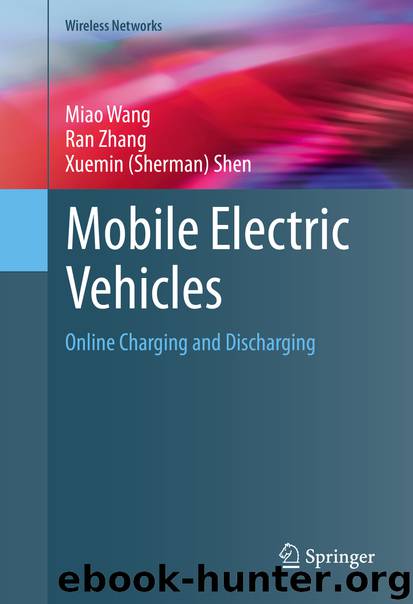Mobile Electric Vehicles by Miao Wang Ran Zhang & Xuemin (Sherman) Shen

Author:Miao Wang, Ran Zhang & Xuemin (Sherman) Shen
Language: eng
Format: epub
Publisher: Springer International Publishing, Cham
(3.14)
where is a constant representing the right hand side (RHS) of inequality (3.13). The inequality (3.14) indicates that the locations and the total number of the charging stations play important roles in the total available power supply to EV charging stations. Given the total power supply to EV charging stations, i.e., , the total load of the EV charging station at Bus j in period k, Pch j, k , presents a linear relation with the others.
3.3.2 Travel Cost for EV Charging
According to Sect. 3.2.3, the travel cost for EV v to be charged in period k, , have two parts. The first part is the travel cost due to the travel distance from the EV v’s current location to a charging station in period k, denoted as p v, k . As mobile EVs may have different locations and battery levels at different periods. Due to the range anxiety, drivers tend to go to the closer charging stations with less travel distance. Thus the travel distance will affect the travel cost significantly. The second part is the travel cost due to the transmission delay for EV v to receive a charging decision through VANETs, denoted as c v, k . The vehicle mobility can cause intermittent transmission delay in VANETs. The resultant intermittent V2V and R2V connections can incur a transmission delay and thus involve an additional travel distance until EV v receives the charging decision from the RSUs or neighboring vehicles. Thus the transmission delay should also be considered when evaluating the travel cost. 1. Travel cost due to the EV travel distance to a charging station: If EV v is scheduled to be charged in the next period k, then . The shortest path algorithm [40] is exploited to calculate the traveling path for EV v to the charging station j in period k by the installed GPS. Denote the path length as S(x v, j, k ). Thus, the travel distance of EV v in period k for charging can be expressed as
Download
This site does not store any files on its server. We only index and link to content provided by other sites. Please contact the content providers to delete copyright contents if any and email us, we'll remove relevant links or contents immediately.
Embedded Programming with Modern C++ Cookbook by Igor Viarheichyk(4093)
Linux Device Driver Development Cookbook by Rodolfo Giometti(4022)
Implementing Cellular IoT Solutions for Digital Transformation by Dennis McCain(4011)
Embedded Linux Development Using Yocto Project - Third Edition by Otavio Salvador & Daiane Angolini(3870)
TinyML Cookbook by Gian Marco Iodice(3775)
Simplifying 3D Printing with OpenSCAD by Colin Dow(2906)
TinyML Cookbook by Gian Marco Iodice & Ronan Naughton(2659)
Fusion 360 for Makers by Lydia Sloan Cline(2308)
Networking A Beginner's Guide by Bruce Hallberg(2290)
Hands-On Linux for Architects by Denis Salamanca(2132)
Computers For Seniors For Dummies by Nancy C. Muir(2106)
But How Do It Know? by J. Clark Scott(2079)
Raspberry Pi and MQTT Essentials by Dhairya Parikh(2040)
Arduino Project Handbook, Volume 2: 25 Simple Electronics Projects for Beginners by Geddes Mark(1999)
9781803246888-ENHANCING DEEP LEARNING WITH BAYESIAN INFERENCE by Unknown(1971)
Hack and HHVM by Owen Yamauchi(1956)
31 Days Before Your CompTIA A+ Exams (Shanette Luellen's Library) by Benjamin Patrick Conry(1925)
Hands-On Internet of Things with MQTT by Tim Pulver(1828)
MicroPython Projects by Jacob Beningo(1820)
